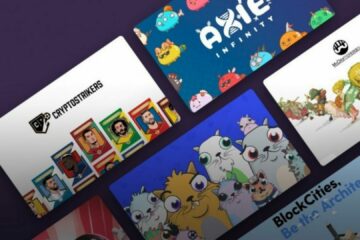Whatever your opinion of them, NFTs have caused a stir. Since the $ 69.3 million sale hit the headlines, they’ve been in the news. And while some question the longevity of the phenomenon (the market has taken a downturn lately), others are convinced they are here to stay. Don’t know what it is? Read on.
Our guide explains everything you need to know about NFTs, including what they are, how they work, why they have sparked some controversy, and how you can get involved. You can check out our favorite NFT artwork here. And if you decide to build your own, don’t forget to deploy this brilliant digital art software.
What is an NFT?
An NFT is, in essence, a collectible digital asset, which has value as a cryptocurrency and as a form of art or culture. Just as art is seen as a valuable investment, so are NFTs now. But how ?
First, let’s break the term down. NFT stands for non-fungible token, a digital token that is a type of cryptocurrency, like Bitcoin or Ethereum. But unlike a standard Bitcoin blockchain coin, an NFT is unique and cannot be traded identically (hence the term non-fungible).
What makes an NFT more special than a regular crypto currency? The file stores additional information, which elevates it above pure money and brings it into the realm of, well, whatever, really. The types of NFTs vary widely, but they can take the form of a digital work of art or a music file – anything that is unique and can be stored digitally and considered to be of value. In fact, they’re just like any other physical collector’s item, but instead of being given an oil on canvas painting to hang on the wall, for example, you get a JPG file.
How do NFTs work?
NFTs are part of the Ethereum blockchain. These are therefore individual tokens containing additional information. This extra information is the important part, which allows them to take the form of art, music, video (and so on), as JPGS, MP3, videos, GIF and others. Because they have value, they can be bought and sold like other types of art – and, like physical art, their value is largely determined by market and demand.
This does not mean, however, that there is only one digital version of an NFT artwork available on the market. In the same way that prints of an original are made, used, bought and sold, copies of an NFT are still valid pieces of the blockchain, but they do not have the same value as the original.
And don’t think you hacked into the system by right-clicking and recording an NFT image, either. This will not mean that you will become a millionaire, as your uploaded file will not contain the information that makes it part of the Ethereum blockchain. You understand ?
Where can I buy NFT tokens?
NFTs can be purchased on a variety of platforms, and which one you choose will depend on what you want to buy (for example, if you want to buy baseball cards, it’s best to go to a site like digitaltradingcards, but d (other marketplaces sell more general pieces). You will need a wallet specific to the platform you are buying from and you will need to fill that wallet with cryptocurrencies. As the sale of Beeple’s Everydays – The first 5000 days at Christies (above) proved, some pieces are starting to sell in more traditional auction rooms, which is worth watching. In case you haven’t noticed, the Beeple coin went for $ 69.3 million.
Due to the high demand for many types of NFTs, they are often put up for sale on the sly (much like in events, where bundles of tickets often go on sale at different times). This means there is a frantic rush of impatient buyers when the sale begins. You will therefore need to register and fill your wallet in advance.
Here is a list of sites that sell NFTs:
- OpenSea
- Super rare
- Nifty Gateway
- Foundation
- VIV3
- Bakeryswap
- Axie Market
- Rare
- NFT ShowRoom
NFTs are also being talked about as in-game purchases in various video games (much to the delight of parents). These assets can be bought and sold by players, and include playable assets such as swords, skins, or unique avatars.
One would expect well-known artists to receive large sums of money in return for their work, which was the case when an anonymous group of “art enthusiasts” burned an original Banksy to transform it. in NFT (for more information, see the video above). But other sales are more surprising. For example, this was Beeple’s first foray into the NFT market and, as well known as a digital artist, this auction was not expected to fetch the third highest price. never paid for a living artist.
And NFTs are a great source of income for brands, as all of the brands that have been on the bandwagon lately show. Taco Bell sold taco-themed GIFs and images (see image above) in a marketplace, and the 25-pack sold out in just 30 minutes. Seriously. Each GIF contained a $ 500 gift card, which the original owner could spend, which may explain their popularity initially. But these TacoCards are now selling in the secondary market, with the most expensive card selling for $ 3,500. And to be clear, this does not include the gift card.
The NBA offers NBA Top Shot, a way to sell digital collectibles in the form of collectible cards featuring iconic moments from the game. With a plan to add virtual jewelry, accessories and clothing that can be used on them. social media, the NBA is looking to find ways to extend this revenue stream as far as possible.
Even tweets are valuable: Jack Dorsey, co-founder of Twitter, sold the very first tweet for a colossal sum of $ 2,915,835.47.
Musicians also sell the rights and originals to their works, as well as short videos or clips of their music, and you can even buy digital real estate and 3D assets like furniture.
In fact, a “digital house” was recently sold for an extraordinary amount of $ 500,000. The “Mars House” (see above), designed by Toronto artist Krista Kim, has been described by the digital art market SuperRare as the “world’s first digital house.” Created with the help of an architect and video game software, the owner will be able to explore the mansion on Mars using virtual reality, including sunbathing outside the house (in the atmosphere of Mars).
Why are NFTs controversial?
There is a lot of money to be made in the NFT market. But you may have heard of some controversy surrounding NFTs, especially regarding their impact on the climate.
NFTs use a monstrous amount of energy for their creation. So much so that many protesters are worried about the very real impact this craze could have on the environment. According to CryptoArt.wtf, a site created to calculate the carbon footprint of NFTs (now offline), a room called “Coronavirus” consumed an incredible 192 kWh for its creation. This is the equivalent of the energy consumption of one inhabitant of the European Union for two weeks. But it must be a particularly huge song, you ask yourself? No, a “simple” GIF can have the same consumption.
Interviewed here, @beeple said, “I can assure you that in the future all my drops will not only be carbon neutral, but carbon NEGATIVE. “I’m sure there are a lot of people who would hold it against him
Artists can help, by making efforts to create carbon neutral artwork (Beeple has already promised to do so in the future, as the tweet above explains). But the problem runs deeper than that, due to the way cryptocurrency systems are constructed.
Ethereum, Bitcoin, and the like are built on a “proof of work” system (like a complex series of puzzles) to secure their users’ financial data, and this system uses an incredible amount of energy. In fact, Ethereum alone consumes roughly the same amount of energy as the entire country, Libya. Ouch.
ArtStation was so worried about the impact on the climate that it recently reversed its decision to sell NFTs after a massive backlash. And Sega was recently the center of a Twitter storm after announcing plans to start making NFTs (after all, Sonic was all about the environment).
But the topic may not be so controversial forever, as there are organizations out there trying to make a difference. Find out here what Blockchain for Climate is doing to improve the situation.



0 Comments